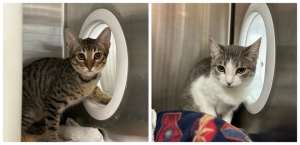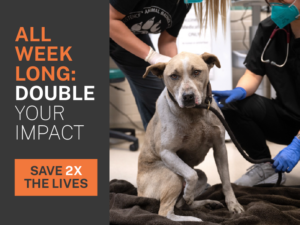Pet hoarding is both animal cruelty and a mental health disorder

A few weeks ago, Pasadena Humane rescued 38 cats and kittens from a cramped trailer. Many of these cats have now recovered and are ready to find new homes. For more information, pasadenahumane.org/adopt.
Hoarding cases are some of the most challenging situations we encounter at Pasadena Humane.
Imagine entering a home with an overpowering smell of ammonia and seeing urine, feces and moldy pet food cans covering the floor.
Then, imagine discovering dozens of suffering animals, with an owner who has no insight into the danger of the situation for the animals or themselves.
Animal hoarding is animal cruelty, but it is also a mental-health disorder. That’s what makes it so complex to address.
The two most common forms of hoarding we deal with are: overwhelmed caregivers who start with a handful of unaltered pets that multiply, or “rescuers” who want to “save” animals and actively attempt to acquire more.
Many people who hoard animals are strongly attached and believe they are helping the animals, despite evidence to the contrary.
A few weeks ago, our team rescued 38 cats living in a small trailer. As you can imagine, the conditions inside were cramped and highly unsanitary.
Most adult cats were healthy, but many of the kittens were sick and emaciated. One kitten tested positive for a highly contagious and often deadly virus, necessitating a quarantine for the entire group once they reached the shelter.
I’m happy to report that most of the cats are now recovered and ready to find loving homes, although sadly, two kittens did not survive.
Unfortunately, more animals are at risk. Our team is actively working on multiple other suspected hoarding cases.
The most up-to-date Diagnostic and Statistical Manual of Mental Disorders defines animal hoarding as the accumulation of a large number of animals and a failure to provide minimal standards of nutrition, sanitation and veterinary care and to act on the deteriorating condition of the animals (including disease, starvation or death) and the environment (e.g., severe overcrowding, extremely unsanitary conditions).
Research indicates that people who hoard are most commonly women over the age of 60. Also, the most commonly hoarded animals are cats. Pasadena Humane’s experience is in line with these statistics.
In a hoarding situation, our primary goal is to gain the trust of the animals’ owner and attempt to get the owner to turn over the animals voluntarily. Working with the hoarder — rather than against them — is usually the best solution for the animals.
When the animals are voluntarily surrendered, they can quickly be made available for adoption. This avoids lengthy and costly legal proceedings which can prevent the animals from finding new homes for months or even years.
Research has also shown that involuntary seizures of the animals are both traumatic to the person who hoards them and ineffective in preventing hoarding in the long run due to a higher rate of recidivism.
Because recidivism is so common (even when animals are voluntarily surrendered), we attempt to maintain an ongoing relationship with hoarders to help keep the situation from spiraling out of control again. Without regular check-ins by our staff, the hoarder will most likely acquire more animals.
In addition to working to keep animals safe, we also try to work with the public health department and/or adult protective services to help the humans involved. Often, we see that toilets, showers and tubs are not in working order. Depression, isolation and other mental illness may also play a role.
For some cases, we work in conjunction with the police department to help us protect the animals involved. Many hoarders are not receptive to help and may even become violent toward our staff members.
If you suspect hoarding in your neighborhood, you can help. Contact Pasadena Humane or your local animal control agency. You can reach us at 626-792-7151.
Dia DuVernet is president and CEO of Pasadena Humane.
This blog post originally appeared as a column in the Pasadena Star-News on July 21, 2023.



